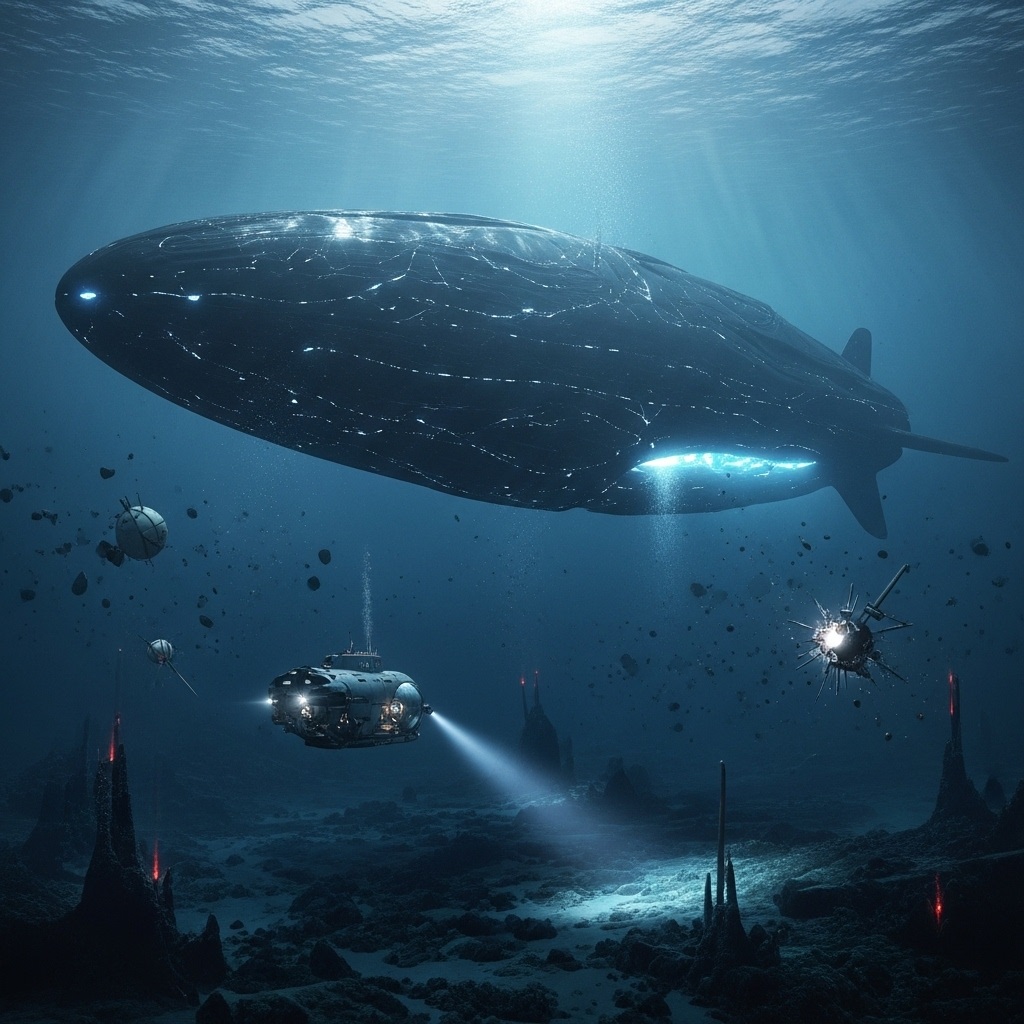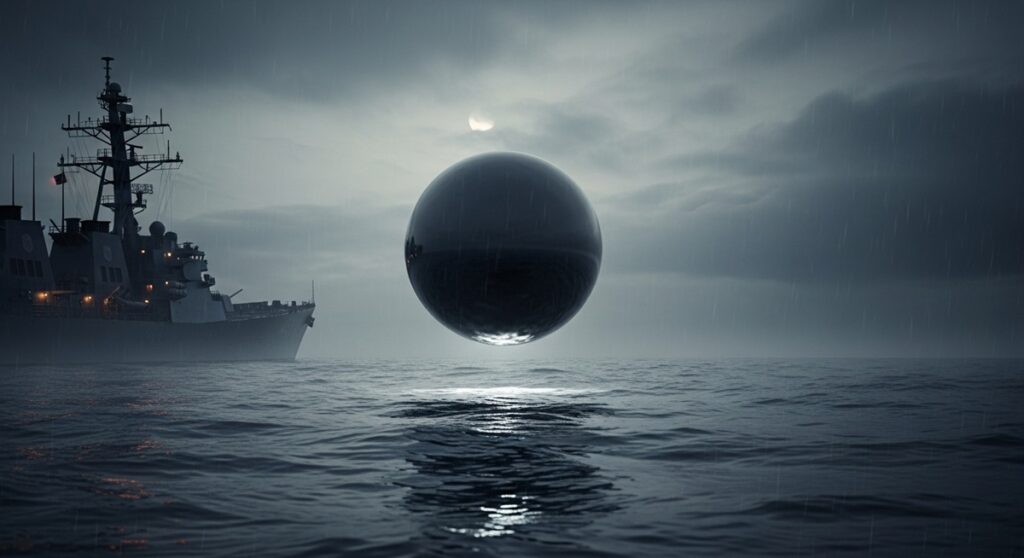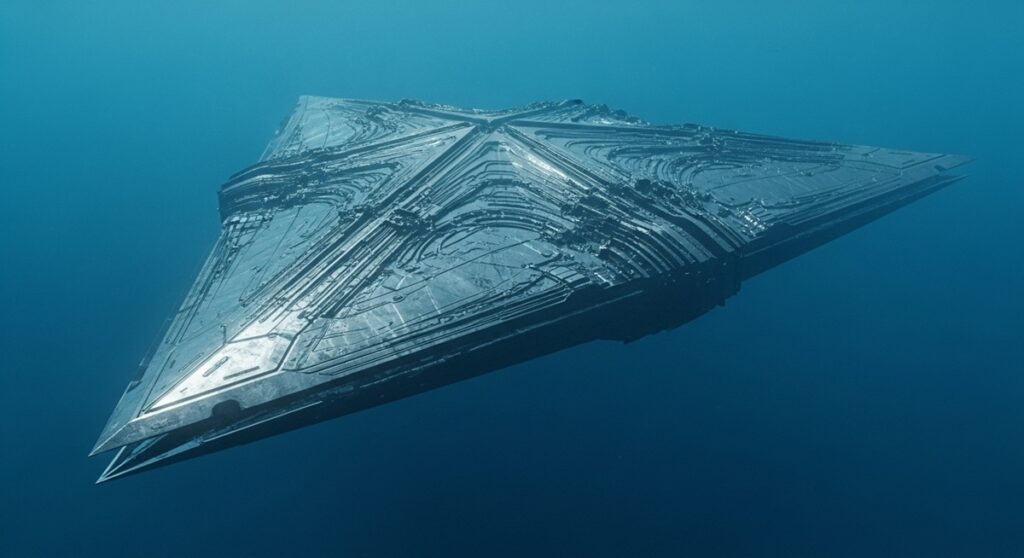While the telescopes of humanity strain toward the distant, cold stars, searching for a signal of cosmic kinship, a terrifying and profound mystery operates directly beneath our civilization’s fragile surface. We are not talking about conventional vessels or the majestic, familiar beasts of the sea. We are discussing unidentified submersible objects (USOs)—massive, multi-kilometer entities that ply the vast, unmapped dark matter of our own planet’s oceans, capable of speeds and maneuvers that defy every known law of physics and engineering.
The paradox is stark and chilling: we know more about the craters on the Moon than we do about the 71% of Earth’s surface covered by water. This ignorance is the perfect cloak for an advanced intelligence. The official line insists these objects do not exist, yet the classified archives of the world’s navies are filled with terabytes of sonar data, video evidence, and the sworn testimonies of high-ranking military officers who have spent their careers watching giants move in the deep. The search for extraterrestrial life, it seems, should begin by gazing downward, into the abyssal plains where reality breaks.
The 10-Kilometer Ghost The Sargasso Sea Incident of 1969

The true scope of the phenomenon was arguably first cemented in the spring of 1969, an incident the U.S. Navy chose to bury for half a century. Forty kilometers off the American coast, sophisticated sonar systems registered something that should have been physically impossible: a massive underwater object of colossal size, estimated by military analysts to be roughly 10 kilometers long—a structure longer than the island of Manhattan.
This enormous object was detected moving at a depth of 600 meters, achieving an astounding speed of approximately 330 kilometers per hour. For context, the fastest modern nuclear submarines can barely touch 80 km/h, and only then with tremendous noise and effort.
The entire East Coast fleet, along with aerial surveillance and even nuclear missile assets, was immediately placed on high alert. The object approached the coastline, closing within 18 kilometers and rising to 420 meters, before executing a sudden, impossible pivot. It turned around with an instantaneous maneuver that defied all known inertia and hydrodynamics, plunging back into the black anonymity of the ocean abyss.
The commander of the naval group in the Sargasso Sea later confessed in a classified report that the object was not only moving but was clearly reacting to their actions. This was not the random drift of an automatic system or a geological anomaly; the object exhibited definitive signs of intelligent control. It was a direct, undeniable challenge from an unknown presence inhabiting the silent core of our world.
Mathematics of the Unexplained
The prevalence of these unexplained phenomena in the ocean far exceeds those observed in the sky, a chilling statistic compiled by military experts like Roman Lingrem. While only 2 to 3% of all documented aerial UFO cases remain officially unexplained, the percentage for unidentified underwater objects (USOs) is staggering: between 50 and 60% of all detection cases lack any rational, conventional explanation. The oceans, in effect, are dozens of times more anomalous than the sky we constantly observe.
Rear Admiral Tim Gallaudet, a former U.S. Navy oceanographer and NOAA head, broke the institutional silence by openly testifying to the U.S. Congress in 2024. He stated unequivocally that the penetration of our waterspace by unidentified objects with unexplained characteristics without a massive military red flag is proof that the government is not sharing all the information. Gallaudet cited a 2015 incident during an exercise with the USS Theodore Roosevelt carrier strike group, where an urgent warning was issued concerning a transmedium object that moved seamlessly from air to water. The implications of this technical superiority are staggering.
Transmedium Challenge USS Omaha and the Vanishing Sphere

The challenge posed by these submerged giants is one of physics impossible. They are not merely faster than our submersibles; they operate in a realm of technology we cannot even conceive of.
On July 15, 2019, the crew of the USS Omaha off the coast of San Diego witnessed one of the most clinically documented events. A spherical object, roughly two meters in diameter, accompanied the advanced warship for an hour, hovering mere meters above the ocean surface. Then, at 23:00 Pacific Time, the object performed the impossible: it suddenly plunged into the water without generating a splash, a crash, or any discernible trace.
The entire event was captured by the AN/KAX-2 infrared camera, a specialized, multi-million dollar surveillance system. Subsequent underwater searches were conducted immediately, finding absolutely no wreckage or evidence of a collision with the water’s surface. The object simply dissolved into the ocean, as if the water were its natural, native environment.
Documentary researcher Jeremy Corbell, who released the video, summarized the colossal intelligence failure this way:
“If some foreign power has the technology to approach our tracking ships undetected and then disappear into the ocean, moving in a way we can’t, it means a colossal failure of defense.”
This transmedium transition violates all known laws of hydrodynamics. Contact with water at such a speed should cause a catastrophic cavitation explosion, visible and audible for miles. The fact that it did not is proof of a physics operating outside our current understanding.
The Submariner’s Nightmare The Quakers of the Barents Sea
The experience of the Cold War navies, particularly the Soviet and Russian submariners, provided decades of terrifying encounters with a phenomenon officially codenamed the “Quakers”—named for the distinct, rhythmic sounds they emitted, reminiscent of the croaking of frogs.
These were not just radar contacts; they were direct, palpable intrusions into military space. Nikolai Tushin, a former Captain of the First Rank and deputy commander of a nuclear submarine brigade, openly admitted the prevailing military theory:
We could be dealing with an unknown underwater civilization.”
The Quakers, whose presence peaked in the late 1970s and spread across the entire North Atlantic, exhibited striking, unmistakable signs of reasonable behavior:
- Superior Speed: They moved at speeds up to 200 km/h—three to four times faster than the nuclear submarines they accompanied.
- Tactical Awareness: They often surrounded Soviet submarines, engaging in what felt like deliberate surveillance or study.
- Active Avoidance: They skillfully avoided active sonar pulses, proving they understood and reacted to our military technology.
- Communication: They reacted to attempts at contact by systematically altering the frequency of their characteristic sounds.
The phenomenon mysteriously faded in the 1980s, giving rise to the speculative theory that a long-term program of observation of humanity during the heightened tension of the Cold War had simply concluded. The observers, having gathered their data, simply withdrew to their deep ocean bases.
The Geography of the Impossible The Metal at the Abyssal Floor

The data points for these inexplicable phenomena are not isolated to a single, chaotic zone like the Bermuda Triangle; they are ubiquitous, spanning the globe from the frigid Arctic and Antarctic waters to the classified reports from the Indian Ocean and the Gulf of Mexico. The USOs are everywhere our most advanced sensors look.
A definitive piece of evidence confirming the artificiality of these giants emerged from a 2009 oceanological expedition off the coast of Greenland. Sonar data revealed a massive three-kilometer object moving at high speed 60 kilometers west of the island. Crucially, hydroacoustic analysis indicated that the object was composed of 85% metal. This entirely rules out the version of a geological formation or a drifting wreck. At three kilometers, this object is over 16 times longer than the largest submarine ever built. It did not merely drift; it actively maneuvered, changing its trajectory with purpose.
The Four Hypotheses of the Deep
The sheer absurdity of the data has forced even mainstream academia to consider radical possibilities. Harry Nolan, a professor of oceanography at Harvard University and a supporter of the Galileo Project, outlines the four major, speculative hypotheses regarding the origin of these submerged giants:
- Alien Underwater Bases: The most common hypothesis. Since oceans cover 71% of the Earth’s surface and we have only explored 5% of their volume, the ocean floor is the perfect place for an extraterrestrial civilization to go unnoticed while conducting long-term observation.
- Ancient Earth Civilization: The unsettling idea that a terrestrial civilization existed long before Homo sapiens and found refuge from global cataclysms in the deep, maintaining a lineage of knowledge and technology far surpassing ours.
- Interdimensional Phenomena: That transmedium objects are not merely technological but represent a mode of operation in dimensions that are beyond our current comprehension of physics, allowing them to bypass physical constraints like inertia and drag.
- Biological Superorganisms: A non-technological explanation suggesting the existence of life forms so fundamentally different from known biology that their metallic composition, colossal size, and speed are mistaken for technological artifacts.
The Political Silence Why the Truth Remains Submerged

Colonel Carl E. Nell (Ret.), a former U.S. Army officer, focused on the physics of the impossible, emphasizing the energy paradox: moving a 10-kilometer metal object at 330 km/h requires energy equivalent to a small nuclear power plant. Where does this energy come from? How is it contained?
The problem is not a lack of data, but a lack of political will to release it. The navies of the world possess terabytes of classified sonar recordings, videos, and sworn testimonies. The scientific community, as Harvard Professor Avi Loeb argues, remains crippled by the fear of stigma. Ignoring empirical data for fear of ridicule is not science; it is dogma.
Rear Admiral Gallaudet directly accused the Pentagon of engaging in disinformation, claiming he was subjected to a months-long influence operation to convince him of the validity of a “seriously erroneous report” from the All Domain Anomalies Resolution Office (AARO). He insists that only an independent commission, protected by Congress and granted access to all naval archives, can break this cycle of silence.
The UAP Disclosure Act, introduced in the U.S. Congress, aims to establish just such a commission. Until then, the silent, cold depths remain the definitive terra incognita—a space we know less about than the surface of Mars.
Meanwhile, deep below us, at pressures that could crush a tank, objects the size of small cities continue their endless, intelligent patrol. They watched us during the Cold War; they accompany our warships now. They demonstrate a mastery of hydrodynamics and energy that we cannot explain. The question has moved past whether they exist. It is now a chilling imperative: Who are they, and what do they want from the civilization that foolishly believes it owns the surface?

















